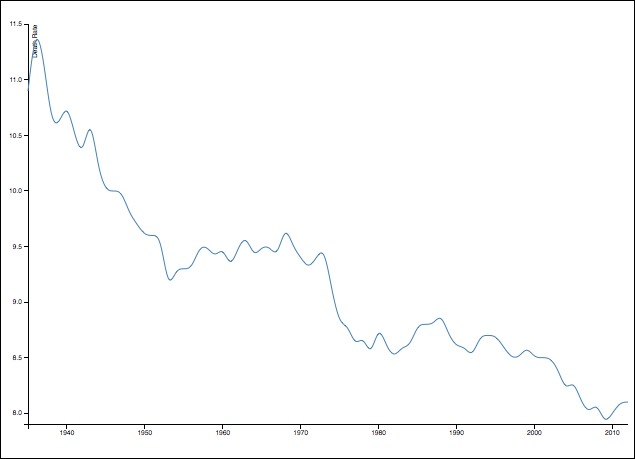How to make a Line Chart in D3
Basic Line Chart

Prepare your data as a CSV file
Make sure your data are real numbers, and have no commas or symbols in them (decimals are OK).
Save your spreadsheet as a .csv file in a folder where you will put the html for your bar chart.
Difference from Bar Chart
The biggest difference in creating a line chart is using the line function in D3.
var line = d3.line()
.x(function(d) { return x(d.date); })
.y(function(d) { return y(d.death); })
.interpolate("basis"); //optional, for smoother lines
This function takes the x and y scale datea x() and y() and it will automatically compute a line. In your chart, you will call this line function as the value of the d attribute of the <path> element.
svg.append("path")
.datum(data)
.attr("class", "line")
.attr("d", line); //we apply the line variable, which we determined earlier
The result will be a path element that is drawn appropriately.
Example of a line chart
<!DOCTYPE html>
<html>
<head>
<meta charset="utf-8">
<title></title>
</head>
<body>
<script src="https://d3js.org/d3.v4.min.js"></script>
<script type="text/javascript">
var margin = {top:50, right:0, bottom:70, left:70},
width = 900 - margin.left - margin.right,
height = 600 - margin.top - margin.bottom;
// parse the date / time
var parseDate = d3.timeParse("%Y");
//Note: If your x scale is not time data, then you'll want to use
// d3.scalePoint() instead for your x variable below
//set the scales based on time
var x = d3.scaleTime().range([0, width]);
var y = d3.scaleLinear().range([height, 0]);
var line = d3.line()
.x(function(d) { return x(d.date); })
.y(function(d) { return y(d.death); })
.curve(d3.curveMonotoneX);
//For examples of different curve styles, see:
// https://bl.ocks.org/d3noob/ced1b9b18bd8192d2c898884033b5529
var svg = d3.select("body")
.append("svg")
.attr("width", width + margin.left + margin.right)
.attr("height", height + margin.top + margin.bottom);
var chart = svg.append("g")
.attr("transform", "translate(" + margin.left + "," + margin.top + ")");
d3.csv("deathrates.csv", function(error, data) {
if (error) throw error;
data.forEach(function(d) {
d.date = parseDate(d.Year); //parseDate(d.Year);
d.death = +d["Crude death rate (per 1,000)"];
});
x.domain(d3.extent(data, function(d) { return d.date; }));
y.domain(d3.extent(data, function(d) { return d.death; }));
svg.append("g")
.attr("class", "x axis")
.attr("transform", "translate(" + margin.left + "," + (height + margin.top) + ")")
.call(d3.axisBottom(x));
svg.append("g")
.attr("transform", "translate(" + margin.left + "," + margin.top + ")")
.call(d3.axisLeft(y))
.append("text")
.attr("transform", "rotate(-90)")
.attr("y", 6)
.attr("dy", ".71em")
.style("text-anchor", "end")
.text("Death Rate");
chart.append("path")
.datum(data)
.attr("class", "line")
.attr("d", line)
.style("stroke","steelblue")
.style("stroke-width","1.5px")
.style("fill","none");
});
</script>
</body>
</html>